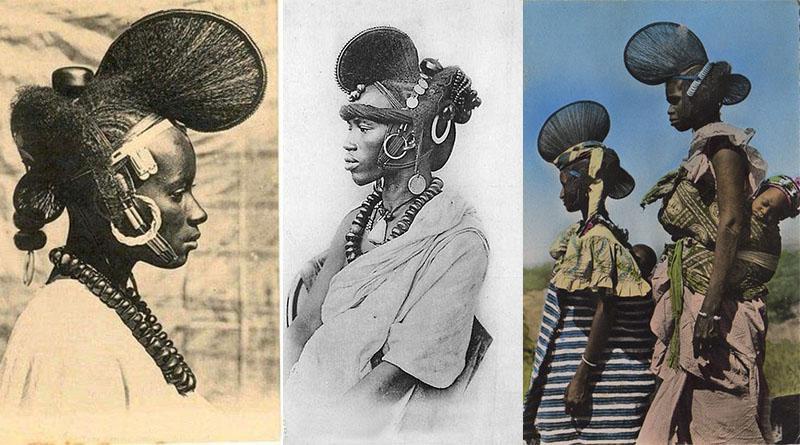This tribe has a highly rich culture, and they know how to put up a stunning appearance. Continue reading to learn the secrets of outstanding hairstyle history.
The Fula, Fulani, or Fule people are one of the most populous ethnic groups in the Sahel and West Africa, with a massive population spread across the continent.
They inhabit in a variety of countries, primarily in West Africa and northern Central Africa, but also in South Sudan, Darfur, Eritrea, and areas around the Red Sea coast. The exact number of Fula people is unknown, although estimates range from 55 million to 69.2 million globally.
The Fulani tribe is found throughout West Africa, with the largest population in Nigeria. The tribe people rely on their rich traditions, which is why their appearance is still dominated by traditional styles.
Women in the tribe usually have long hair, which is seen as a symbol of femininity and beauty. Hair that has been braided is likewise highly popular. Splitting the hair into five sections and braiding it is a ritual.
Typically, family jewelry is included into braids. They can adorn the hair with rich stones, valuable coins, or other ornaments. Fulani wedding hairstyles frequently highlight the most attractive features of a traditional look.

Hairstyles, like Fulani traditional dress, can vary based on the locality. However, it solely applies to women’s hairstyles; men in all of the tribe’s locations wear short hairstyles.
So, let’s take a closer look at the classic Fulani hairstyle:
Fulani braid hairstyles
Braids are highly popular among the tribe’s women. Cornrow braids and didi braids are the most common styles. The braids are usually weaved in ornate patterns, with the ends dangling from the sides or wrapped. They use jewelry or red beads to embellish the braids.
Thin-to-medium patterns are frequently used to style the braids. Fulani braided hairstyles are now fashionable all over the world. This hairstyle is frequently used by modern designers, and it is frequently combined with different styles. Top buns, various colors of braids, diverse patterns, and numerous beads can all be seen.
Decorations in the hairstyles
Fulani women are known for adorning their hair with numerous ornaments. Veils are one of the most popular ornaments. The veil highlights one area of the head while concealing the rest. Another common ornament is thread, which is best fashioned in gold.
Jewelry or beads are the next type of adornment. The rule for this style of décor is that the bigger the better.
Braid ornaments
The ornaments can be extremely tough and complex. Patterns, circles, and intertwinings can all be found in Fulani hairstyles. Traditional Fulani hairstyles are known for their beauty all over the world. Braids have been fashionable among many celebrities worldwide, not just in Africa. As a result, we may conclude that the Fulani hairstyle tradition has influenced global fashion. Even now, the Fulani people maintain their aesthetic customs and support their culture.
Fulani History and timeline
The Fulani people’s origins are unknown, and several explanations have been proposed. According to certain researchers of Fulani history and the Sokoto Caliphate, the Torankawa clan (Torodbe) of the Fulani can be traced back to an Arab named Uqba bin Nafi. They have wandered through and among numerous cultures as a nomadic herding group.
Their oral histories hint to a beginning in Jordan or further east, although their language is from the Senegambian region, according to Skutsch. He comes to the conclusion that the contemporary Fulani people originated in northern Senegal.
In his book The History of the Upper Guinea Coast, Walter Rodney claims that the Fulbe are from North Africa and that they conquered the Foota Djallon region under the leadership of the Fulani Koli Tenguella.
Interactions between an ancient West African population and North African populations such as Berbers or Egyptians may have started the ethnogenesis of the Fulani people. Their West African roots might be found in and around the Senegal River valley.
They are thought to be a genetic mix of West African, North African, and Arabian peoples, and have been a part of a number of governing dynasties, mainly in the Sahel and West Africa. During the period of European invasion and colonization, theories concerning their origins began to circulate.
Timeline of Fulani history
| 4th century | The Ghana Empire emerges in modern-day southeastern Mauritania and western Mali, as the first large-scale Sudano-Sahelian empire |
| 5th century | The Ghana Empire becomes the most important power in West Africa |
| 5th century (?) | The Fulbe migrate southwards and Eastwards from present-day Morocco and Mauritania |
| 9th century | Takrur founded on the lower Senegal River (present-day Senegal) upon the influx of Fulani from the east and north settling in the Senegal River valley |
| 11th century | Kingdoms of Tekruur and the Gao Empire flourish in West Africa due to gold trade |
| 1042 | Almoravids, Berber Muslims from southern Morocco and Mauritania, attack Takrur, after defeating the Sanhaja in 1039 |
| 1050s | Islam gains a strong foothold in West Africa |
| 1050-1146 | Almoravids take over Morocco, Algeria, and part of al-Andalus; they invade Ghana in 1076 and establish power there. |
| 1062 | Almoravids found capital at Marrakesh |
| 1100 | The Empire of Ghana starts to decline in influence and importance |
| 1147 | The Almohad Caliphate, ruled by Berber Muslims opposed to the Almoravids, seize Marrakesh and go on to conquer Almoravid Spain, Algeria, and Tripoli |
| 1150 | An unprecedented resurgence of the Ghana Empire sees it reach its height, controlling vast areas of western Africa as well as Saharan trade routes in gold and salt |
| 1200 | Empire and themselves set out on a road of conquest, they take its capital Koumbi Saleh in 1203 |
| 1235 | Great warrior leader Sundiata Keita of the Mandinka people founds the Mali Empire in present-day Mali, West Africa; it expands under his rule |
| 1240-1250 | Mali absorbs Ghana, Tekruur and the Songhai Empire |
| 1324 | 10th Emperor of Mali, Musa I of Mali regarded as the richest individual in recorded history, goes on his famous pilgrimage to Mecca, Saudi Arabia. his procession reported to include 18,000 workers who each carried 4 pounds (1.8 kg) gold bars, heralds dressed in silks who bore gold staffs, organized horses and handled bags. Musa provided all necessities for the procession, feeding the entire company of men and animals. Also in the train were 80 camels, which varying reports claim carried between 50 and 300 pounds (23 and 136 kg) of gold dust each |
| 1325 | The Empire of Mali reaches its height of power, covering much of Northern West Africa. |
| 1352 | Ibn Battuta, Berber scholar, travels across Africa and writes an account of all he sees |
| 1462 | Sonni Ali becomes ruler of the Songhai people and goes on to build the Songhai Empire |
| 1490 | The Mali empire is overshadowed by the Songhai Empire |
| 16th century | Songhai Empire enters a period of massive expansion and power under Askia Mohammad I. Askia Mohammad strengthened his country and made it the largest contiguous territory ever in West African history. At its peak, the Empire encompassed the Hausa states as far as Kano (in present-day Nigeria) and much of the territory that had belonged to the Songhai empire in the west neighbouring Bornu Empire of the Kanuri |
| 1515 | The Songhai Empire reaches its zenith and pinnacle of power |
| 1590 | Songhai Empire is defeated by invading Moroccans from further North |
| 1650 | Another wave of Fulbe migrations sees them penetrate even further in the Southern Senegal and Fouta Jallon highlands of middle Guinea |
| 1670 | Fulani people gain control of Bhundu in Senegal with Malick Sy, and the Sissibhe |
| 1673 | First unsuccessful Fulani jihad in the Fuuta Tooro |
| 1808 | Bornu successfully repel Fulani forces |



 The African History Truly African
The African History Truly African

